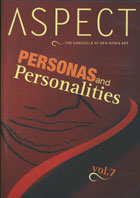
Personas and Personalities (Aspect: Chronicle of New Media Art, Vol. 7) 2006
Distributed by Microcinema International/Microcinema DVD, 1636 Bush St., Suite #2, SF, CA 94109; 415-447-9750
Produced by Michael Mittelman
Directed by various artists
DVD, color, 74 min.
College - Adult
Art, Media Studies, Psychology
Date Entered: 09/11/2006
Reviewed by Brian Falato, University of South Florida Tampa Campus LibraryAspect is a magazine in DVD format that compiles short experimental videos and other media art. Each volume has its own theme. Volume 7 is called Personas and Personalities. It contains contributions from ten artists and focuses on the construction of identity and role-playing, along with the influence society and the mass media have on this construction.
Each video has a commentary track by a museum curator or art critic that can be played over the original audio of the video. In many of the videos presented in this compilation, this commentary track is needed because it provides background and context. Watching the video without this commentary can leave the viewer less than impressed by the apparent lack of content. The important thing for these pieces is the concept behind the work, rather than the content of the work itself.
For instance, the first video on the disc, Bequeaths, shows two similar-looking women in side-by-side images talking simultaneously as they make their wills on video. The commentary informs us that the two women, called Cariana and Cariane, have created a separate legal identity called CarianaCarianne, two separate shelves in a shared body. Their work focuses on this duality.
Evidence Locker is footage shot on city streets. A woman in a red coat appears in all the shots, sometimes from a distance and sometimes in close-up. It turns out that this material was taken entirely by video surveillance cameras in Liverpool, England. The city has set up 242 cameras and all the footage recorded is retained for thirty days, and then erased, unless needed in a legal proceeding. While this raises obvious civil liberty issues, artist Jill Magid is not overtly concerned with this in her video. She worked closely with the Liverpool police and even had some shots staged for the cameras. At the end of the video, she is seen riding on the back of a motorcycle driven by a Liverpool policeman, as the Georges Delerue composition “Camille’s Theme” from the movie Contempt is heard on the soundtrack. The romantic feel of the ending contrasts with the thorny questions raised about the source of the images.
The most audacious video on the compilation is one that was unknowingly created by the BBC. It’s mislabeled WTO on the DVD container, but it’s a BBC News interview with a Dow chemical company spokesman, or so the BBC thought. Dow purchase Union Carbide Corporation in 2001. Union Carbide became notorious in 1984 when a pesticide plant it operated in Bhopal, India leaked 27 tons of a deadly gas that killed 20,000 and left 120,000 with serious illnesses that will need lifelong care. Union Carbide had denied taking responsibility for the incident, and Dow did likewise after acquiring the company. Then in 2004, the BBC ran an interview with a man identified as a spokesman for Dow who said Dow would liquidate Union Carbide and use the money to compensate victims and fully remediate the damage done at the site. It would also cooperate with all legal investigations into the gas leak. The BBC aired the interview twice before it was discovered the “Dow spokesman” was actually a member of The Yes Men, a group which impersonates business leaders to get media coverage that will provoke discussion about the ethical responsibilities of the business involved.
Not all of the videos require commentary to be appreciated. More Man shows youth football players and the often harsh comments made by their coaches, and Tea Party shows the violence lurking behind social facades. Boop-oop-A-Doop is the most visually compelling selection on the disc. It manipulates documentary film footage of Marilyn Monroe and combines it with images of cartoon character Betty Boop to comment on the construction of feminine identity as represented by these two icons.
The relationship between humans and machines and its effect on human identity are also explored. The Veils of Transference features a psychotherapy session between a human and a robot, with the roles of therapist and patient alternating between the two. The concept of human-robot communication also occurs in Lynn Hershman’s brief video DiNA. The Day We Met views relationships through the prism of karaoke videos, and Kristin Lucas’ Involuntary Reception is an interview with a woman, played by Lucas, who says she has difficulty coping with the modern world because she gives off electromagnetic fields that damage all the machinery and people she comes in contact with.
The disc can be viewed as a whole to get an overview of current work in media art, but individual videos can be used in many classes besides art because of the issues raised. Each artist’s work is presented on a separate chapter, so there is ease of navigation to any individual piece.